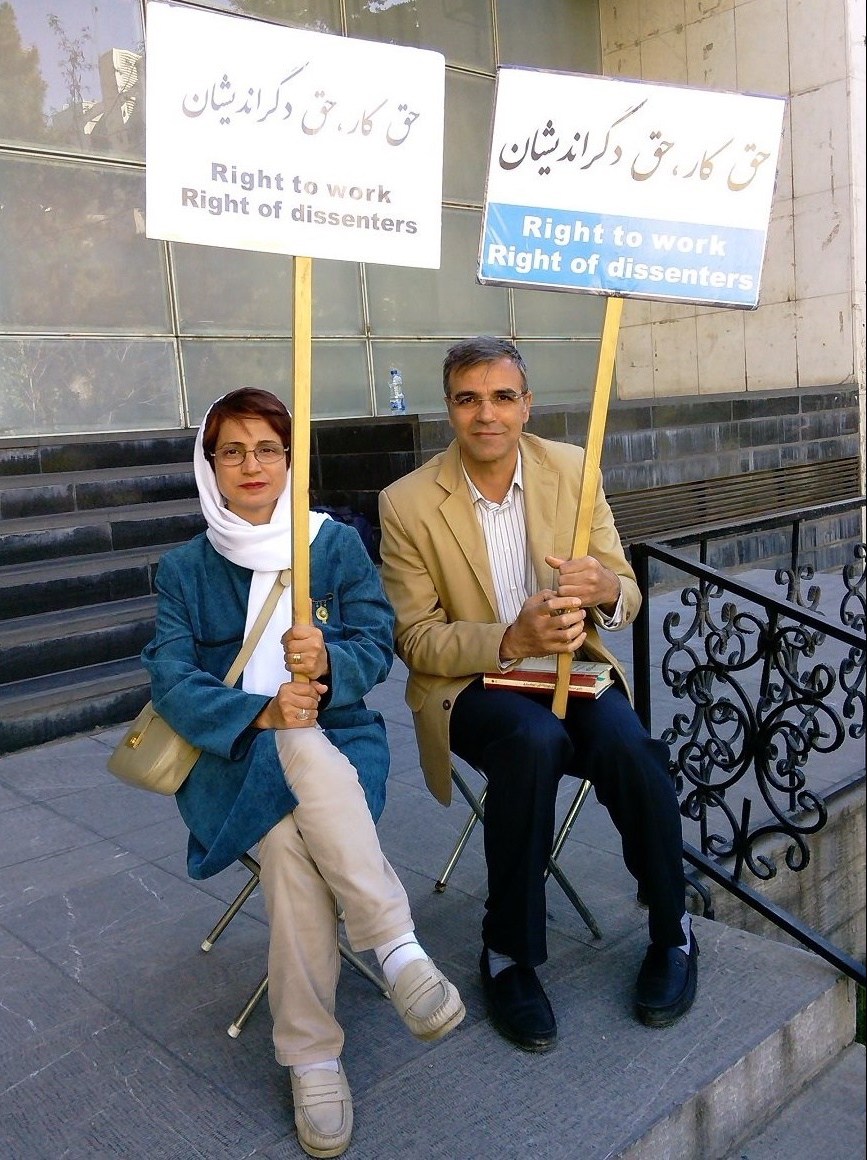
“Unbearable”: Reza Khandan, Husband of Nasrin Sotoudeh, on the Ground in Iran’s Qarchak Prison
The little girl is three years old. She approaches my wife Nasrin Sotoudeh who is sitting in a corner of the prison yard and asks, “Aunty, can you tell me the Rolling Pumpkin story?” Sonbol is a beautiful girl with golden hair, born here at Qarchak prison. Her mother was pregnant when she was arrested for bank robbery. Now they live in a place the inmates call “the end of the world.”
Nasrin has been unjustly and cruelly imprisoned since June 2018 for her legal work representing Iranian human rights and women’s rights activists. She was sentenced to 38 years in prison and 148 lashes. Under the law she must serve at least 12 years. In October 2020, Nasrin was taken out of Evin prison and told she was being taken to the hospital to have treatment for her heart condition. They lied and drove her to Qarchak. Soon after she arrived, Nasrin caught COVID-19. She told me that coronavirus had spread in her ward and many inmates became sick.
Qarchak prison—the women’s prison of Tehran province—is located on the outskirts of a town called Qarchak, 25 miles south east of Iran’s capital, Tehran.
Eleven years ago, the Iran Prison Organization decided to establish a women’s prison in Tehran. Since there were no empty prisons available, a structure that originally had been an industrial cow barn and later served as housing for drug addicts was chosen to temporarily hold female inmates until an appropriate facility could be built. That never happened.
Qarchak holds over 1,400 women, many convicted of violent crimes. A wall has been built around the prison without observing any building standards or using appropriate materials. It is surrounded by camel and ostrich farms. The first time I drove to the prison, to my absolute surprise, I found camels roaming in the parking area.
At Qarchak, 13 inmates have small children. Sonbol is one of them. Once Nasrin asked her if she’d ever been out of the prison on furlough. “Yes, one time.” she answered, “My dad bought me kabob and rice. It was very delicious.”
A young woman who served time in Qarchak told me that she entered the ward with painted nails because it could not be taken off with a regular nail polish remover. One of the children who was born inside had never seen nail polish before. She was so surprised that she asked how it was possible. “What beautiful nails, Aunty!” the little girl exclaimed. “Can my nails be colored, too?”
Many of the wards are a place where women sentenced for serious crimes exercise authority and dominance. Extortion, starting fights, and attacking other cellmates with broken glass and razors are normal day-to-day activities for them. Rape and sexual abuse are among the most dangerous threats some of these prisoners impose on others.
Since there is not a proper sewer for a prison of this size, a foul smell permanently permeates the prison’s air. Nasrin says, “I always feel that my lungs are filled with the smell of sewage.”
The first time I visited the prison office to discuss a furlough for Nasrin, I took a few steps and that smell Nasrin described hit me. I asked the officer escorting me about the origin of the odor. He told me he didn’t know, but added, “It’s always there. It never goes away.” Apparently, at the beginning of his posting to the prison, he got so sick from the smell that he was prescribed two weeks rest to recover.
Since the weather has warmed up, the stench has become unbearable. It is so rancid that it feels like they are living deep inside a sewer. Nasrin’s letters and complaints about the situation have gone unanswered.
Last Monday was visitation day at the prison. I noticed the rain from the night before had soaked up many of the prisoners’ carpets and blankets. The roof of Nasrin’s ward, which covers a number of rooms, was leaking in at least ten spots. Even though prisoners had placed pots and pans under the leaks, water was everywhere.
In response to Nasrin’s complaints, the security officer in charge said, ′′See, the roof of my room is leaking too.” She couldn’t resist a sardonic reply: “Would you like us to come repair your office?”
Nasrin also reports that along with all sorts of insects and cockroaches, they have spotted tarantulas inside the prison.
Overcrowding is so serious that every ten-square meter cell holds twelve beds—four rows of triple bunk beds. None of the rooms have windows or air filtration systems. Instead of following architectural standards and design principles, the prison authorities continue to haphazardly add walls to extend the space and bring in more inmates.
The state of the bathrooms in the prison is another sad story—one that cannot be described in words. I have taken a photo of a bathroom in the parking lot that officers, bus drivers and visitors including lawyers can use. This toilet is unimaginably dirty and dilapidated. And, of course, there is no soap. A friend who had spent time in solitary confinement in Qarchak told me that the toilets in the solitary cells are much worse. Solitary confinement is used to punish prisoners, and it is a true disaster in every sense of the word. Those on death row must also spend the last days of their lives there. Entering these cells is like being transported back to the Middle Ages.
It is not clear what the source of water in the prison is, but it is so salty and untreated that over time it causes irreversible damages to the kidneys and other organs.
Source: MS Magazine



